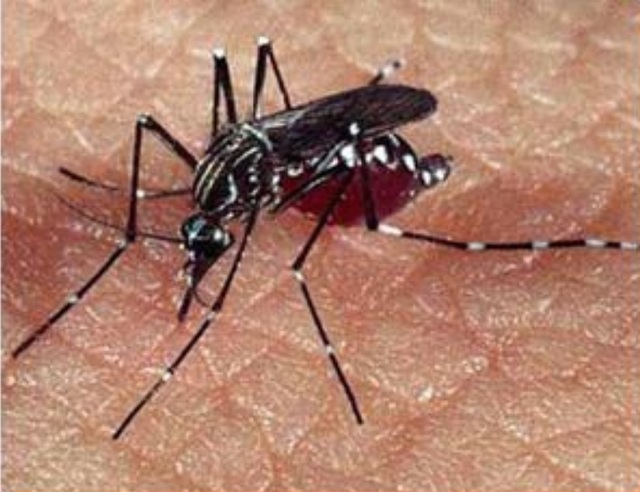State moves to head off dengue outbreak
The state Department of Health has been inundated with calls reporting possible cases of dengue fever since officials confirmed an outbreak here earlier this week.
ADVERTISING
However, as of Friday afternoon, the official total remained at two confirmed cases and four probable cases waiting on confirmation, said State Epidemiologist Dr. Sarah Park.
“I don’t have a new update at this point, but on Monday I fully anticipate, because we’ve gotten so many reports now and our lab is testing … we’ll have updated numbers,” she said.
Health officials said they cannot reveal information about the patients or where the cases have been reported because the investigation into the source of the mosquito-borne disease is ongoing. They did say, however, they think dengue was brought to the island by a traveler because the disease is not endemic to the island.
“Unfortunately, we cannot pinpoint a place. … It’s so hard to know. We’re not trying to hide anything, we’re just not sure at this point. It’s looking like pretty much a good portion of the Big Island is a potential risk. … I do suspect that there is not one particular hot-spot,” Park said. “We’re looking for a few, at least.”
Several online commenters and Tribune-Herald readers have been critical of the decision not to release more information about where the illness has been reported.
“Residents have a right to know if they are living in a potential hot-spot in order to take strong precautions,” wrote Hilo resident Merle Hayward in a letter to the editor. “… Please report the information we all need to have in order to keep ourselves safe.”
Added website commenter “windplr”: “I want to know where this is occurring, and I’ll bet a lot of others do as well.”
Park said she understands the public’s need to have more information, and that is something she and other Health Department employees are working diligently toward, despite staffing and budget cutbacks during the past several years.
“Our environmental folks, as strapped as they are, are trying to do what they can, and this is why we have to support our vector (control) folks,” she said.
Currently, two epidemiology investigators are operating on Hawaii Island — one based in Hilo and another in Kona.
“They’re running around all over the island right now,” Park said. “They’ve been interviewing patients, retrieving charts, getting blood drawn. They have their work cut out for them. … We’re in touch with them, and we’ll mobilize folks from the other islands if we need to. Right now, the Big Island folks are pulling together.”
Park added mosquitoes tend to remain close to home, not moving more than 200 yards from where they hatched. So, the biggest factor in the spread of the disease is the movement of the humans infected with it. Wherever they travel on the island, they then have the potential of spreading dengue to local populations of mosquitoes.
One concern, she added, is that the Ironman World Championships in Kona earlier this month could have contributed to spreading the disease, with multiple athletes and their families from around the world potentially bringing it here, or spreading it off-island after being bitten by mosquitoes here.
“One of the things we’re trying to figure out is how do we get the word out to them, to report back to us if they did come down with an illness. We are reaching out to Ironman organizers to reach through them directly to the athletes,” Park said.
An outbreak on Hawaii Island is of particular concern to health officials, she added, because the prevalence of a particular mosquito here provides the potential for the disease to become endemic, meaning it would continuously infect the mosquito population.
While the mosquito species Aedes albopictus is spread throughout Hawaii and is capable of carrying dengue, the disease tends to die off on its own. Not so for Aedes aegypti, which has been found in pockets on the Big Island.
“We do worry for the Big Island,” Park said. “Especially if we don’t get on top of this, it could settle there, and that’s bad news for everyone.”
The best thing people can do if they come down with symptoms similar to dengue is to tell their doctors and ensure the Department of Health is informed, she said. Also, people who are infected should take care to keep indoors while they are recovering to prevent being bitten by mosquitoes and spreading the disease further.
“We’re looking for people to have proactive prevention,” she said. “Stay away from areas with mosquitoes. Get rid of areas with standing water. We’re not saying they need to be spraying DEET all over the place, but if there are heavily mosquito-infested areas they can use DEET. Just be aware of mosquito precautions.”
The Hawaii Department of Education reported late Friday afternoon the school system had been in contact with the Department of Health and is taking steps to keep students safe.
“Big Island schools are monitoring the situation and will be taking precautions to eliminate standing water on campuses to reduce any potential mosquito breeding areas. Health room staff will also be looking for any signs as well,” wrote spokesman Derek Inoshita.
Email Colin M. Stewart at cstewart@hawaiitribune-herald.com.
———
INFO BOX:
Info courtesy the Hawaii Department of Health
What is dengue fever?
Dengue fever is a viral illness spread by mosquitoes. The disease occurs mainly in tropical Asia, Africa, the Caribbean and the South Pacific. It is most common during the rainy season in areas infested with infected mosquitoes. Sometimes, persons arriving from other countries may enter the United States with dengue fever and infect local mosquitoes, as happened in Hawaii in 2001.
How do you get it?
The dengue virus is spread through the bite of infected Aedes mosquitoes. Dengue is not spread directly from one person to another.
What are the symptoms of dengue fever?
The symptoms of dengue fever include sudden onset of fever, severe headaches, eye, joint, and muscle pain, and rash. The rash typically appears on the hands, arms, legs and feet 3 to 4 days after the fever begins. Minor bleeding problems can also occur. The symptoms usually go away completely within 1 to 2 weeks. Sometimes, people with dengue fever have blood clotting problems. When this happens, the illness is called dengue hemorrhagic fever. Dengue hemorrhagic fever is a very serious illness with abnormal bleeding and very low blood pressure (shock).
When do symptoms start?
The symptoms usually start 5 to 6 days after being bitten by infected mosquitoes, but the onset can range from 2 to 15 days.
What is the treatment for dengue fever?
There is no specific treatment for dengue fever. Bed rest and acetaminophen (Tylenol) to treat fever and pain are recommended. Aspirin and NSAIDS (ibuprofen, naproxen) are not recommended as they can make bleeding problems worse. There is currently no vaccine for dengue fever.
If you get dengue fever once, can you get it again?
Yes. There are four major types of dengue viruses. Having dengue fever with one type of dengue virus will not protect you from the other three types.
How can you keep from getting it?
When traveling to areas that have dengue fever, try to avoid exposure to mosquitoes. Aedes mosquitoes are usually most active in the early morning hours after daybreak, in the late afternoon before dark, and any time during the day when indoors or in shady areas.
Use mosquito netting over beds, and screens on windows and doorways.
Use mosquito repellents and wear appropriate clothing such as long-sleeved shirts and long pants that reduce exposure to mosquito bites.
Mosquitoes are drawn to dark colors; so if possible, wear white or light colored clothing when you are likely to be exposed to biting mosquitoes.




